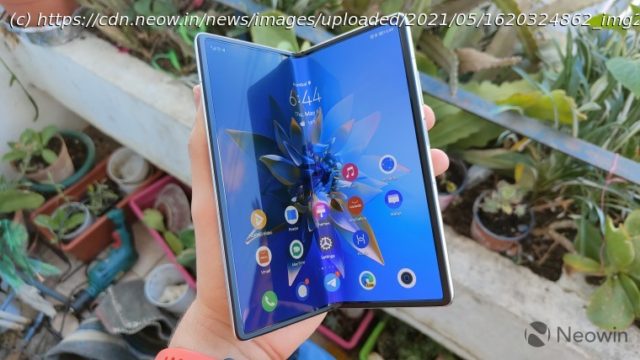Huawei recently released its third foldable phone in China, taking some ideas from Samsung and carving some of its own. Despite its ingenious design, the Mate X2 still has lessons to learn.
It’s been over two years since the first foldable phone made its way to the market. I find that it’s a little crazy to think that it’s been that long, and that’s because despite it being two years now, these products still feel like a complete novelty. Despite numerous concepts, Samsung and Huawei have pretty much exclusively been the only companies releasing new models, and even then, they’re still ridiculously expensive. The Samsung Galaxy Z Fold2 launched for a whopping $1,999, and even the less impressive Galaxy Z Flip 5G costs $1,200 after a big price cut earlier this year. Even as a reviewer, it’s been hard to get my hands on one. Huawei released the Mate X2 foldable in China a few months ago, and it really doesn’t make things look a whole lot better in terms of making the foldable market more approachable. While international availability and pricing is still a mystery, the Chinese model starts at over $2,700. Now, the company has sent me a unit of the Mate X2 to try out, and I got a full week with it. I had a few minutes with the original Mate X at MWC 2019, and then with the Galaxy Fold later that year, but nothing that allowed me to really appreciate the features of those phones. Still, I choose not to call this a full review because first, I don’t like making assessments based on a period as short as one week; and second, I think it’s pointless to try and tell you that you should buy this phone. Aside from the fact that it’s availability is still extremely limited, justifying that price point was always going to be an impossible task. I don’t think the discussion around foldables as they are right now should focus on whether you should buy them, but rather on what each one brings to the table that we should hope to see in future iterations, what other companies should learn from them, and what still needs to improve. So let’s take a look at what Huawei did right with the Mate X2 and what needs to be done to make future foldables better. 24-core Mali-G78 Exterior: 6.45 inches,1160×2700 (21:9),456ppi,90Hz refresh rate, OLED, Glass cover Interior: 8 inches,2480×2200 (8:7.1),413ppi,90Hz refresh rate, OLED, Plastic cover Unfolded dimensions: 161.8 x 145.8 x 4.4-8.2mm (6.37 x 5.74 x 0.17-0.32in) Folded dimensions: 161.8 x 74.6 x 13.6-14.7mm (6.37 x 2.94 x 0.54-0.58in) Weight: 295g (10.41oz) White (as reviewed), Black, Crystal Pink, Crystal Blue Let’s start with the design, which I think is truly where the Huawei Mate X2 shines the most. Unlike the original Mate X, the company has opted for a inner folding screen paired with a flat external display, similar to Samsung’s Galaxy Z Fold line. Unlike its competitor, though, the inner display is covered by plastic, but since it’s protected when it’s closed, I think this is much less of an issue. Plus, while it is very impressive that Samsung created its Ultra Thin Glass that’s able to fold, some users have noticed micro-cracks forming along the crease, so some work may still be required on that type of harder material. Additionally, Huawei is using a new folding mechanism that’s somewhat reminiscent of the Motorola razr, where the display curves into a waterdrop shape when it folds. Huawei says this helps the crease be less noticeable since it’s spread out over a wider area, and I’d say it works really well in terms of the visual effect, which is helped by the reduced reflectivity of the display cover that Huawei also touts. You need to look at the display from an unusual angle to see the crease, and even when you see it, it’s not that distracting. You do feel it when you move your finger over it, though, but the rest of the display feels pretty solid considering the cover is made of plastic. What I think makes the design truly special and unique is how Huawei tried to cram most of the components into one half of the phone. When you unfold it, it gets thicker and thicker towards the right side, and while that may seem odd, it’s actually great for usability. it reminds me of Amazon’s Kindle Oasis, which is purposefully designed to be thicker on one side. What that does is that it puts most of the weight of the device directly on your hand, so you don’t feel like it’s going to tip over on the other side, and that means you can use it with one hand more easily than other foldables without straining your fingers to hold it. When you fold it, each half of the phone aligns in a way that makes it almost completely flat, so the odd shape isn’t really noticeable when you’re just using it as a normal phone. Its design also makes it noticeably thinner than Samsung’s Galaxy Z Fold2, and it’s actually manageable with one hand, even though it’s obviously much thicker than your average smartphone. As I said above, I haven’t had a ton of time with other foldables to make a direct comparison, but Huawei did some great work here. The hinge on the Mate X2 feels pretty good, but it’s also a fairly new unit, and the real question with these devices is how well they hold up over time. There is some noise from the plastic flexing when you open and close the phone – but that’s to be expected, according to Huawei – and otherwise everything feels as solid as can be. The phone slams shut with very strong magnets that are actually a bit challenging to separate when you want to open it, but you can get used to that. Just to round out some parts of the design, there are stereo speakers on the top and bottom of the phone, specifically in the thinner half, along with a SIM card slot on the top edge.
Home
United States
USA — software Huawei Mate X2 hands-on review: an expensive foldable with an ingenious design






